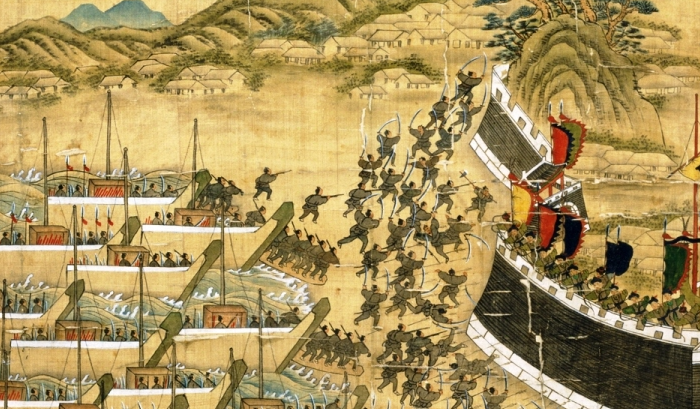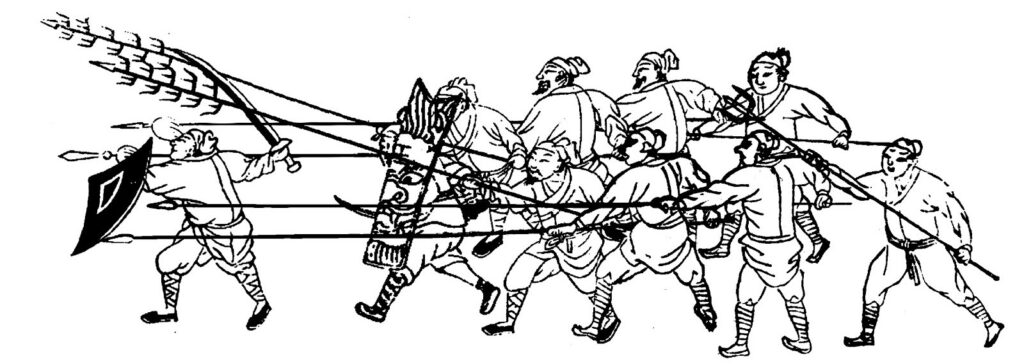In the 16th century, Ming China was beset by coastal raiders from Japan. The Chinese army, defanged by two centuries of systematic degradation, was powerless to stop these ‘pirates’. It’s a perfect place for PCs to step in!
These coastal raiders, called ‘wokou’, were more than just brigands. Their core members were Japanese soldiers, veterans of Japan’s Warring States period, looking for easy money. These battle-hardened fighters were well-equipped, experienced, and disciplined. Fighting alongside the Japanese were even greater numbers of disaffected Chinese locals. The wokou formed stateless armies, sailing were they pleased and taking what they willed. They built inland bases and besieged cities. They formed alliances with the rural Chinese gentry, who’d grown rich trading illegally with Japan. The wokou threatened the very foundation of Ming rule in coastal China.
This post is brought to you by beloved Patreon backer Justin Moor. Thanks for helping keep the lights on! If you want to help keep this blog going alongside Justin, head over to the Patreon page (link: Patreon.com/MoltenSulfur ) – and thank you!

The core, Japanese, wokou typically landed in coastal China aboard scores of ships, each carrying about a hundred men. They carried the ’twin swords’ (daishō), eight-foot-tall bows, and occasionally guns. They fought in squads of no more than 30 men, and coordinated their tactics by waving folding fans and blowing on seashells. To awe their opponents, they wore mirrors, horns, and colored strings, so they seemed to flash in an otherworldly fashion.
After landing, the wokou would recruit from among the locals. For every Japanese wokou, there would be five to ten native auxiliaries, sometimes bringing total force strength up to 20,000 troops. The auxiliaries worked as scouts, screening forces, porters, native guides, picket troops, skirmishers, and reserves.
Once the wokou were established in an area, they’d proceed to pillage it methodically. The raiders were interested in valuables, sure, but also trade goods they could resell later. They even collected silk cocoons and assigned local women to spin them into silk thread. Over the winter, they would quarter on Chinese soil. These ‘pirates’ turned pillage into an industry.
The wokou are easy to fictionalize to fit your setting. Find an appropriate overseas (or interplanetary) nation for their core fighters to come from, remove any details that don’t fit your setting, and voila! A ready-made force of antagonists made memorable by its local auxiliaries, methodical plundering, and colorful appearance. Their use of small-unit tactics (squads of 30 men or less) is well-suited to the gaming table, because a crack party can plausibly take on a single squad and win – provided the PCs are clever in their use of the battlespace.

China’s defenses weren’t up to the task of stopping the raiders. Threatened towns had to bribe local commanders to march on the wokou. Even then, the Chinese soldiery would flee at the first sight of the enemy. The Ming military had been suffering from a litany of woes for two hundred years: no centralized authority, no funding, no battlefield experience or doctrine, no formal training for officers or enlisted, no supply depots, unstandardized or low-quality equipment, and unending civil service interference. This was an army that numbered in the hundreds of thousands on paper, but didn’t exist in practice.
The man who would ultimately defeat the wokou arrived in coastal China in 1555: General Qi Jiguang. To do this, he first had to completely rebuild the army. He oversaw recruitment and training, invented a new style of fighting, drafted manuals of tactics and doctrine, and built supply lines from scratch. The force Qi ultimately fielded was bizarre to Western eyes. It relied on the Ming army’s greatest strength – its manpower – while minimizing the impact of its poor equipment.
Qi organized his recruits into twelve-man squads. In the front were two men carrying swords and rattan shields and two men carrying sharpened bamboo trees, complete with upper branches they could use to harry and tangle up the enemy. These four defenders kept the enemy from approaching the squad closely enough to engage them. Behind the defenders were four men with twelve-foot spears, who thrust over and between the men in front of them. Behind the spearmen were two men carrying tridents who could step in where needed. A corporal and a cook-porter rounded out the twelve.
(Though it’s not the focus of this post, throwing one of these these twelve-man squads against your PCs in a combat encounter could be super fun, especially in a tight space like a bridge or mountain switchback.)

While your game’s version of Qi Jiguang is rebuilding his military from the ground up, it’s a perfect opportunity for your PCs to shine! The army is coming. It’s up to the party to hold off the raiders until then.
The PCs might take out a wokou raiding party or two to establish a reputation. They could infiltrate wokou bases to assassinate the raiders’ (frequently Chinese) leadership, burn the Japanese ships, or throw finished silk in the river to ruin it. They can’t single-handedly throw the wokou out of your version of China, but they can keep the raiders on the defensive and make their business less profitable. This may not induce any Japanese wokou to go home, but it’ll make the Chinese wokou more likely to desert and return to their farms.
Source: 1587: A Year of No Significance: The Ming Dynasty in Decline by Ray Huang






